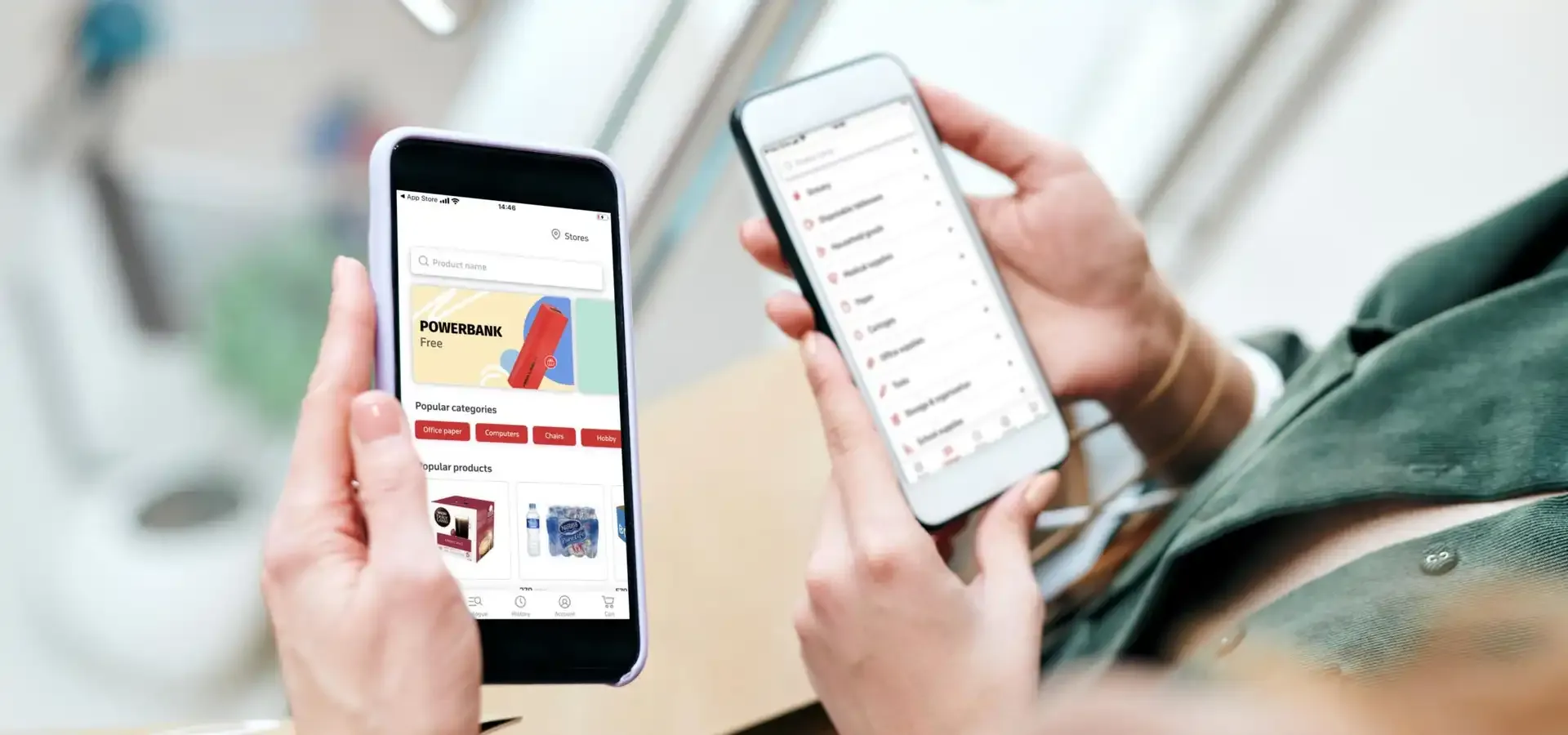Services
SERVICES
SOLUTIONS
TECHNOLOGIES
Industries
Insights
TRENDING TOPICS
INDUSTRY-RELATED TOPICS
OUR EXPERTS

May 6, 2025
There are several models for enterprise application integration (EAI) that address different business needs and have their strengths and limitations.
The point-to-point approach involves creating direct connections between two applications using pre-built connectors or custom code. Point-to-point integration establishes two-way communication between the apps to exchange data without intermediary software, which allows for faster data transfer without delays.
In point-to-point integration, the connected apps become tightly coupled so that changes in one app (e.g., changes in the app’s business logic or data structure) call for updates in the other one. Moreover, this approach becomes ineffective for larger app networks since each pair of applications requires a separate connection that needs individual monitoring, updates, and troubleshooting. Such complex maintenance can strain an organization’s resources and negatively affect overall system performance.
In the hub-and-spoke model, applications within a company’s network are linked to a centralized hub instead of being connected directly to each other. Each app, or spoke, sends data to the hub, which transforms and routes it to the destination app.
With a single point of monitoring and controlling all message flows, system interactions, and data transformations, IT teams can add new applications to the integration environment more easily without affecting existing integrations. Moreover, the centralized integration hub helps improve the safety of the integrated IT environment by enforcing security policies and access controls as well as minimizing the attack surface. However, the hub also represents a single point of failure, whose crash or downtime can fail the entire integrated system. What’s more, the performance of the hub-and-spoke architecture can degrade as data volumes grow or too many spokes are added.
Application 1
Application 2
Application 3
Application 4
Application 5
Application 6
Integration broker (HUB)
The most common EAI solution today, the enterprise service bus approach is based on the hub-and-spoke model and provides a highly flexible integration platform to establish communication between multiple systems using a service-oriented architecture (SOA). Applications connect to a centralized communication bus that receives messages from one endpoint and transforms and routes the message to the destination endpoint.
ESB components are reusable, which allows for the addition of new applications to the integrated environment. However, ESB requires specialized technical knowledge, which makes its implementation and maintenance complex and expensive. Additionally, intricate ESB processes can cause latency in data flows as the number of endpoints increases.
iPaaS is a cloud-based software service that automates integration activities, enabling businesses to easily connect almost any type and number of on-premises and cloud applications without the need to install or manage middleware or hardware. The iPaaS service provider handles the technical side of app integration (like integration infrastructure maintenance or platform security updates) and offers a no/low-code interface for users to configure and manage connections.
iPaaS platforms often have batch and real-time data processing capabilities and can orchestrate data flows across multiple applications. However, as iPaaS platforms rely on pre-built connectors and templates, they can fail to support complex integrations. In addition, iPaaS vendor lock-in can be a concern.
An API is a set of rules or protocols that enables applications to communicate with each other and share data. The API serves as a bridge between the application that sends a request and the application that responds. By sharing information in small packets relevant to the specific request, API integrations expose only the necessary information and keep other system and device data inaccessible.
In the context of enterprise application integration, middleware is intermediary software that enables connectivity and communication between business applications that weren’t originally designed to work together. Middleware provides services that facilitate data translation and transmission across apps through common messaging frameworks, without the need to connect every application with each other. There are several types of middleware that serve as an integration hub for enterprise applications, including message-oriented middleware (MOM), ESB, and iPaaS.
Applications interact and exchange data through various messaging protocols and standards that define how messages should be processed, prioritized, and routed. Popular communication protocols for enterprise application integration include AMQP, MQTT, JMS, REST, gRPC, and SOAP.
Data mapping is the process of connecting data fields in the source application with the corresponding data fields in the target application. For example, a “Customer ID” field from a CRM system can correspond to “Client ID” in an analytics platform, or “Full Address” in the CRM can be split into separate “Street,” “City,” and “Zip Code” fields in the order management system. Data mapping defines the relationships, transformations, and rules for data transmission, ensuring the data retains its integrity and meaning as it flows between the systems.
In integrations with event-driven architectures (like serverless ones), events are significant occurrences in one application that trigger a specific action or request for data transmission in another application (e.g., the placement of a new order in an ecommerce store triggers an update in the inventory management system). An example of event-driven communication is a webhook that automatically sends a message when a predefined event occurs, allowing apps to interact and share information in real time.
Our specialists analyze your business requirements and audit your existing IT infrastructure to help you shape a long-term application integration strategy and achieve enterprise interoperability. As part of this strategy, we define optimal integration approaches, select suitable technologies, and develop a step-by-step roadmap, guiding you throughout the integration deployment process.
We also review your existing app integrations to identify opportunities for enhancing their performance, scalability, and maintainability, recommending relevant optimization steps.
We design and implement secure and reliable application integration solutions end-to-end for you to connect any internal or external systems and their components hosted on-premises or in the сloud. Before and after deployment, we test the new integrations to ensure they function smoothly and create a seamless, cohesive environment.
We connect diverse sensors, devices, and applications into a unified IoT network to enable seamless data exchange, automation, and enhanced decision-making. Our IoT experts design IT architectures that can easily accommodate new devices and increased data volumes while streamlining communication between all network elements to support real-time data processing.
Seamless sharing of enterprise data between applications allows for the automation of routine processes, enhances collaboration between teams, and increases data accuracy and consistency.
Employees can easily access necessary data without switching between different applications and perform tasks quicker, reallocating their time toward more high-value activities.
Through integration, companies can extend the capabilities of their applications, utilizing their existing IT resources more effectively and eliminating the need to adopt additional software.
By connecting their consumer-oriented applications to internal systems or third-party solutions, companies can speed up task execution for customers, extend their service offering, and deliver more personalized experiences.
Since application integration is a complex initiative, companies should carefully plan the process to avoid potential issues during the integration process.
Feasibility | Before starting application integration, organizations should study the technical, economic, and operational viability of the upcoming integration initiative, ensuring it will support the business objectives and deliver maximum benefit. |
|---|---|
Technical expertise | Application integration requires deep technical knowledge not just to make important project decisions like the choice between architectural approaches with real-time vs. batch processing or synchronous vs. asynchronous communication, but also to successfully implement them in the way that meets the company's performance, reliability, and scalability requirements. The implemented integrations must also facilitate accurate and consistent data exchange between the connected applications, even in the face of failures. |
Compatibility | Applications can have unique architectures and use different technology stacks, data formats, and communication protocols. Establishing a reliable connection between these apps requires a well-thought-out integration strategy and significant development efforts related to middleware, data transformation, or custom interfaces. |
Security & compliance | Integrating multiple apps, particularly with different security protocols, can introduce vulnerabilities due to a larger attack surface and increase the risk of data breaches and unauthorized access. Companies should make sure that both apps and sensitive data stay safe and all relevant security regulations are met once the integration is set up. |
Available resources | While being considered a more cost-effective solution than developing new systems, app integration still requires a significant investment of time, money, and human effort. First, companies should allocate the resources for the most pressing integration needs to cover high-impact areas that deliver immediate value. Then, they can connect other apps in iterations to spread the investment over time. |
Licensing costs | If third-party integration tools are used to connect applications, organizations should factor in the software licensing or subscription fees, which often depend on the number of integrations created, the planned volume of connectors and API calls, and the level of support required from the vendor. |
Post-deployment maintenance | Continuous monitoring of the performance and security of the implemented integrations are crucial for the success of any application integration initiative. Therefore, when building their integration strategies, organizations should factor in the resources they’re ready to designate for the integration maintenance activities as well as the integration scalability needed to accommodate larger data volumes and new apps as the business grows. |

With organizations relying on a wide range of applications to manage their business functions, the need for seamless connectivity between internal and external software solutions and web services is increasing. Companies that resort to application integration can remove barriers between their disparate software systems to accelerate digital transformation and improve the efficiency of business operations. Team up with a reliable technology partner like Itransition to connect your applications securely.
Both application integration and data integration facilitate access to information contained in different systems. However, the two processes differ in focus and goal.
Application integration | Data integration | |
|---|---|---|
Focus | Connecting siloed applications to enable data exchange between them. | Consolidating data from different sources into a single repository. |
Goal | To streamline business workflows and improve collaboration across departments. | To provide a complete, accurate dataset for further analytics to generate business insights. |
Example | Sharing lead information from a marketing app with a sales management solution to help the sales team engage potential customers. | Extracting patient data from an integrated EHR system and copying it into the hospital’s data warehouse for doctors to analyze patient trends. |
Companies from startups to large enterprises across industries can benefit from connecting almost any software application they use:
Internal corporate apps
e.g., an enterprise resource planning (ERP) system like Microsoft Dynamics 365 can be integrated with accounting
and supply chain management software to automate workflows across departments
Third-party services
e.g., a CRM solution like Salesforce can be integrated with an email marketing platform for extended CRM functionality
There’s a wide range of open-source and proprietary iPaaS platforms that offer various app integration capabilities. Azure Logic Apps, Boomi, Power Automate, Zapier, MuleSoft, Informatica, and Workato are among the application integration tools ranked high by software review providers.
To choose an iPaaS platform that will best fit your app integration needs, evaluate the available options based on the following factors:

Case study
Get more details on how Itransition developed a mobile app for an online retail chain based on SAP Commerce.

Service
Itransition is a custom application development company building powerful software for SMBs and large enterprises. Get a free quote now.

Insights
Explore common ERP integration methods and types, their pros and cons, along with major challenges and best practices for successful ERP system integration.

Service
Itransition provides legacy application modernization services, helping companies revamp outdated software of any type to make its operation more efficient.

Service
Dynamics 365 integration services | Secure Dynamics 365 integration with the Microsoft ecosystem and third-party business apps | Certified Microsoft developers.

Service
Learn what apps are commonly integrated with Salesforce and explore the key integration patterns, steps, and best practices.

Service
A certified Odoo partner, Itransition helps companies integrate Odoo with third-party software, ensuring smooth data flow and system compatibility.

Service
Tap into application security consulting by Itransition. We offer security testing services to evaluate and enhance your digital assets protection.